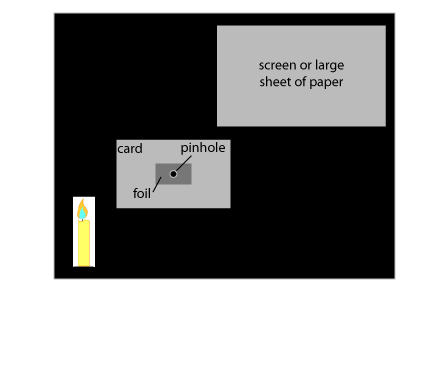Skip over navigation
Or search by topic
Number and algebra
Geometry and measure
Probability and statistics
Working mathematically
Advanced mathematics
For younger learners
Pinhole Camera
Age 11 to 14
Challenge Level 





Equipment required
- sheet of card
- screen or large sheet of white paper
- blackout for windows
- aluminium foil, about 5cm x 5cm
- pin or sharp point
- tape
- scissors
- ruler
- candle or other light source

Making the pinhole camera
- Cut a square about 2cm x 2cm in the centre of the cardboard.
- Put the foil over the square hole and tape it to the card.
- Use the pin or point to make a small hole in the foil.
Setting up the pinhole camera
To get an image with your pinhole camera:
- Set it up as in the diagram and turn out all other lights.
- You should be able to see an image of the candle flame or other light source on the screen - try different positions and see what gives the best image.
Investigating your pinhole camera
- What do you notice about the image? Why do you think it is like this?
- What happens to the size of the image as you move the sheet of paper or screen further away, but with the candle staying still? You could draw a graph of image height (vertical axis) against the distance of the paper or screen from the pinhole camera (horizontal axis).
- Look at your graph - what do you think it tells you?
- For each pair of measurements, calculate the result when you divide the height of the image by the distance between the camera and the screen or paper. What do you notice? Can you explain this?

